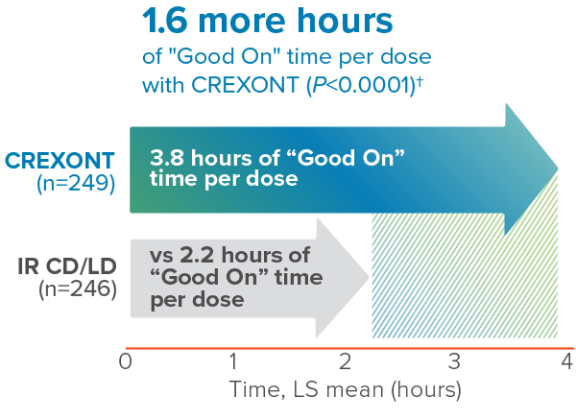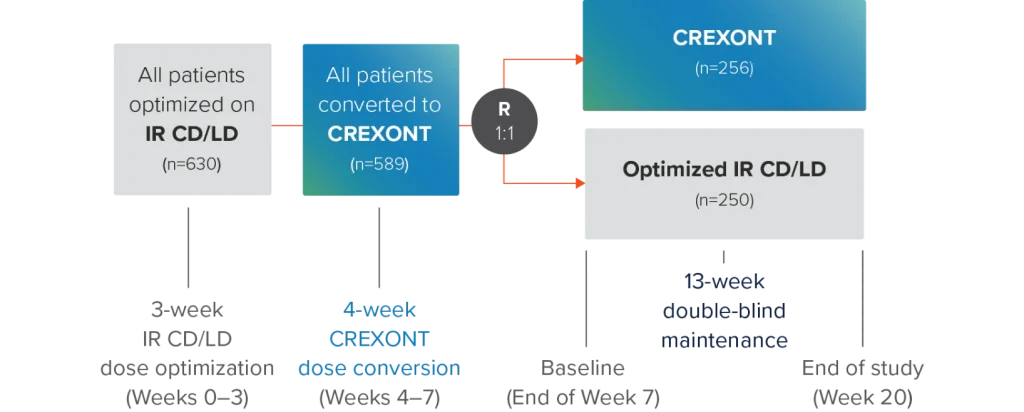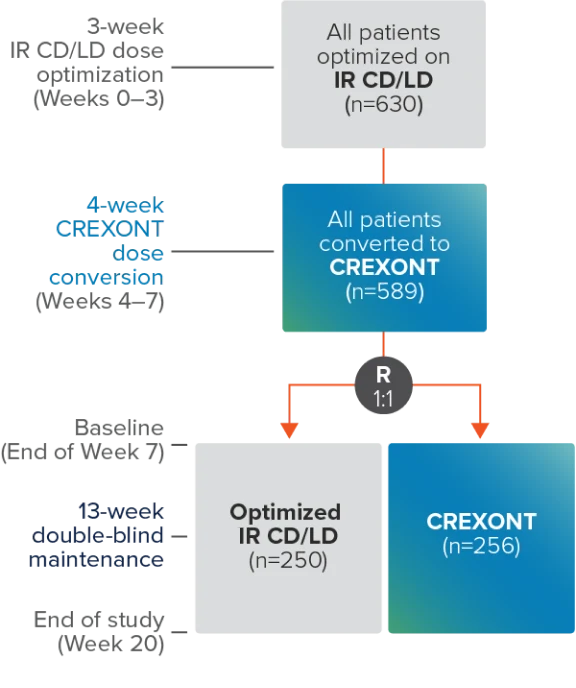Efficacy
CREXONT delivered more “Good On” time with less frequent dosing vs optimized IR CD/LD in the RISE-PD study1,2

Primary endpoint result: “Good On” time per day1,2
Statistically significant improvement in “Good On” time (0.5 hours per day) with patients taking CREXONT® (carbidopa and levodopa) extended-release capsules vs optimized IR CD/LD in the RISE-PD head-to-head study (P=0.019)1,2*†
Patients took CREXONT an average of 3 times per day vs an average of 5 times per day with optimized IR CD/LD.
“Good On” time per day2‑4

CREXONT was compared to optimized IR CD/LD in the Phase 3, randomized, double-blind RISE-PD study. The dosing of IR CD/LD and CREXONT was optimized for all patients during 2 sequential open-label periods: Weeks 1–3 for IR CD/LD, followed by Weeks 4–7 for CREXONT. Baseline and 1:1 randomization (N=506) began at the end of Week 7 for the 13-week, double-blind maintenance period with dosing based on the regimens established during the open-label period. The primary endpoint was the mean change in “Good On” time per day from baseline to end of study or early termination.2
*0.5 hours per day is the LS mean difference.2
†P value based on change from end of Week 7 (baseline) to Week 20 (end of study or early termination), as assessed by the patient’s PD diary.1,2
CD/LD=carbidopa/levodopa; IR=immediate-release; LS=least squares; PD=Parkinson’s disease.
Secondary endpoint results
Patients reported less “Off” time1,2
Significantly less “Off” time (0.5 hours per day) with less frequent dosing with CREXONT vs optimized IR CD/LD (P=0.025)1,2*†
- Change in “Off” time from baseline to end of study or early termination (hours) for CREXONT: 4.0–4.2 (LS mean difference: 0.4) vs IR CD/LD: 4.0–4.8 (LS mean difference: 0.9)1,4
*0.5 hours per day is the LS mean difference.2
†P value based on change from end of Week 7 (baseline) to Week 20 (end of study or early termination), as assessed by the patient’s PD diary.1,2
CD/LD=carbidopa/levodopa; IR=immediate-release; LS=least squares; PD=Parkinson’s disease.
Post hoc analysis of primary endpoint: “Good On” time per dose2
CREXONT provided 1.6 more hours of “Good On” time per dose vs optimized IR CD/LD2*
1.6 more hours of “Good On” time per dose represents a 70% increase vs optimized IR CD/LD
“Good On” time per dose2,4

With CREXONT, “Good On” time lasted significantly longer (1.6 hours) per dose (P<0.0001)2,4*
*”Good On” time per dose was defined as daily “Good On” time (hours) divided by the daily dosing frequency in the subject’s stable dosing regimen, as determined at the end of the dose adjustment period for subjects randomized to IR CD/LD and at the end of the conversion period for subjects randomized to CREXONT.2
†1.6 more hours per dose is the LS mean difference.2
CD/LD=carbidopa/levodopa; IR=immediate-release; LS=least squares; PD=Parkinson’s disease.
Study design
The RISE-PD head-to-head study evaluated the efficacy of CREXONT vs optimized IR CD/LD1,2
In a Phase 3, randomized, double-blind study1,2


- Mean change in “Good On” time per day from baseline to end of study or early termination
- Mean change in “Off” time per day from baseline to end of study or early termination
- Stage I–IV PD per Hoehn and Yahr scale
- 3-day average in “Off” time lasting ≥2.5 hours per day with ≥1.5 hours of cumulative “Off” time per day†
- A stable regimen of CD/LD for ≥4 weeks that included a total daily dose of ≥400 mg LD and ≤2400 mg LD from IR CD/LD alone, or IR CD/LD and a bedtime dose of controlled-release CD/LD
- CD/LD dose frequency of 4–9 times per day
*Dosing was based on the regimen established at the end of Week 7 for CREXONT and at the end of Week 3 for IR CD/LD. No new dose adjustments could be made during the double-blind maintenance period.2
†“Off” time per day refers to patient’s waking hours.4
CD/LD=carbidopa/levodopa; IR=immediate-release; PD=Parkinson’s disease; R=randomization.
Characteristics/demographics of randomized patients at study entry
RISE-PD evaluated 506 patients with PD over the 13-week, double-blind maintenance period1,5
| CHARACTERISTIC | CREXONT (n=256) | IR CD/LD (n=250) |
|---|---|---|
| Age (years), mean (SD) | 66.1 (9.0) | 66.5 (8.9) |
| Gender, males, n (%) | 159 (62.1) | 177 (70.8) |
| Age of onset of PD (years), mean (SD) | 57.7 (9.1) | 58.3 (9.6) |
| Stage II–IV PD per Hoehn and Yahr scale, % | 89.4 | 91.6 |
| Screening Montreal Cognitive Assessment Score, mean (SD) | 27.3 (1.8) | 27.2 (1.8) |
| MDS-UPDRS Part III (“On”), mean (SD) | 24.7 (16.0) | 24.9 (15.6) |
| MDS-UPDRS Part III (“Off”), mean (SD) | 45.5 (14.0) | 45.6 (14.1) |
| “Off” time (hours), mean (SD) | 6.1 (2.2) | 6.1 (2.2) |
| “Good On” time (hours), mean (SD) | 9.5 (2.2) | 9.6 (2.3) |
- Overall, patient characteristics were balanced across both treatment groups5
- At study entry, both groups experienced approximately 6 hours of “Off” time and approximately 9.5 hours of “Good On” time per day5
CD/LD=carbidopa/levodopa; IR=immediate-release; MDS-UPDRS=Movement Disorder Society-Unified Parkinson’s Disease Rating Scale; PD=Parkinson’s disease; SD=standard deviation.
Explore the proven safety profile
IMPORTANT SAFETY INFORMATION
Indications and Usage
CREXONT® (carbidopa and levodopa) extended-release capsules for oral use is indicated for the treatment of Parkinson’s disease, post-encephalitic parkinsonism, and parkinsonism that may follow carbon monoxide intoxication or manganese intoxication in adults.Dosage and Administration
- Levodopa-naïve patients: Starting dose is 35 mg carbidopa/140 mg levodopa taken orally twice daily for the first three days; thereafter, dosage may be increased gradually as needed
- For patients converting to CREXONT from immediate-release carbidopa/levodopa, dosages are not substitutable on a 1:1 basis. See full prescribing information Section 2.2 for instructions
- For patients converting from Rytary® (carbidopa and levodopa) extended-release capsules, initiate CREXONT on an approximately 1:1 mg basis using the levodopa component for conversion
- CREXONT may be taken up to four times daily. The maximum recommended daily dosage is 525 mg carbidopa/2100 mg levodopa
- CREXONT may be taken with or without food. Capsules should not be chewed, divided or crushed
- CREXONT should not be taken with alcohol
Contraindications
Nonselective MAO inhibitors.Warnings and Precautions
- CREXONT may cause falling asleep during activities of daily living, somnolence or dizziness. Patients should avoid activities that require alertness such as driving and operating machinery until they know how CREXONT affects them
- It is important to avoid sudden discontinuation or rapid dose reduction to reduce the risk of withdrawal symptoms such as high fever or confusion. Patients who are discontinuing CREXONT should taper off with healthcare provider guidance
- Consider dose reductions or stopping CREXONT in patients with hallucinations or impulse control disorders (e.g., gambling, sexual urges, or uncontrolled spending)
- Consider dose reduction in patients with dyskinesia
- Patients with a major psychotic disorder should not be treated with CREXONT
- Monitor patients with a history of cardiovascular disease for cardiac function
- Monitor patients with a history of peptic ulcer for upper GI hemorrhage
- Monitor patients with glaucoma for increased intraocular pressure
Adverse Reactions
The most common adverse reactions (incidence ≥ 3% and greater than immediate-release CD/LD) are nausea and anxiety.Drug Interactions
Iron salts and dopamine D2 antagonists, including metoclopramide, may reduce the effectiveness of CREXONT.Use in Specific Populations
Pregnancy: Based on animal data, CREXONT may cause fetal harm. There are no adequate data on the developmental risk associated with the use of CREXONT in pregnant women.Breastfeeding: The developmental and health benefits of breastfeeding should be considered along with the mother’s clinical need for CREXONT.
Geriatric patients: There were no differences in safety outcomes between patients less than 65 years of age, 65-75 years of age, or 75 years and older.
To report SUSPECTED ADVERSE REACTIONS, contact Amneal Specialty, a division of Amneal Pharmaceuticals, LLC at 1‑877‑835‑5472 or the FDA at 1‑800‑FDA‑1088 or www.fda.gov/medwatch.
Please see full Prescribing Information for CREXONT.
Content is for guidance only. Please use clinical judgment when prescribing CREXONT. Dosage is individualized for each patient.

